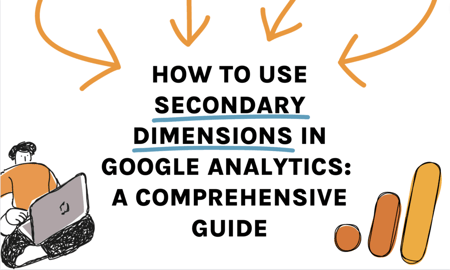Thorough Look at Secondary Dimensions in Google Analytics: Meaning and Ideal Practices
Thorough Look at Secondary Dimensions in Google Analytics: Meaning and Ideal Practices
Blog Article
Revealing the Effect of Secondary Measurement in Google Analytics on Information Analysis and Insights
In the world of data analytics, the use of additional dimensions within Google Analytics has actually arised as a pivotal device for extracting deeper insights and unraveling facility patterns that could or else remain covered. By peeling off back the layers of main information sets, second measurements provide a nuanced perspective that improves the understanding of customer actions, internet site efficiency, and the effectiveness of advertising and marketing strategies. The true influence and untapped capacity of second measurements are commonly underestimated, overshadowed by the attraction of main metrics. As we browse with the elaborate landscape of data analysis, the relevance of secondary dimensions ends up being increasingly obvious, clarifying essential information that hold the secret to notified decision-making and critical optimizations.
Discovering the Idea of Secondary Dimensions
Secondary measurements in Google Analytics supply added insights by permitting customers to evaluate main data in combination with a secondary feature. By integrating additional dimensions, individuals can dive deeper into the data and discover important correlations that may otherwise go undetected - what is a secondary dimension in google analytics.
By checking out the different additional dimensions offered in Google Analytics, customers can unlock new understandings and maximize their electronic marketing initiatives. In significance, secondary measurements offer as an effective tool for enhancing information analysis and driving workable results.
Enhancing Data Interpretation With Second Measurements
Having actually developed the foundational understanding of secondary dimensions in Google Analytics and their pivotal role in data evaluation, the focus currently moves in the direction of leveraging these second credit to boost the interpretation of analytics data (what is a secondary dimension in google analytics). By integrating secondary measurements right into information evaluation, analysts can gain much deeper insights into customer behavior, internet site efficiency, and advertising efficiency

Moreover, secondary dimensions assist in contextualizing primary data metrics by supplying added layers of info. This contextualization help in recognizing the 'why' behind the information patterns, assisting experts make informed decisions and optimizations to improve general performance. Inevitably, incorporating additional measurements improves the data analysis process, causing more tactical activities and meaningful insights.
Revealing Hidden Insights Through Additional Dimensions
Exploring the midsts of analytics information with second measurements discloses valuable understandings that would otherwise stay obscured. By incorporating additional measurements in Google Analytics, companies can discover concealed patterns, trends, and correlations that give an even more extensive understanding of customer habits and web site efficiency. These extra layers of information allow analysts to dig much deeper right into the primary dimensions, such as website traffic sources or touchdown web pages, and get an extra nuanced perspective on just how different variables interact with each other.
Via using additional dimensions, analysts can section and contrast data across various dimensions, enabling them to recognize certain variables that affect user engagement, conversion prices, and total success metrics. For instance, by coupling the primary measurement of 'gadget group' with the second measurement of 'age team,' marketing experts can identify which age demographics favor accessing the web site with smart phones versus desktop computers. This degree of granularity equips organizations to make data-driven choices and maximize their approaches for better results. Ultimately, uncovering hidden understandings through additional measurements enhances the depth and precision of data analysis, leading to more enlightened decision-making and boosted efficiency results.
Leveraging Secondary Measurements for Actionable Analytics
Building upon the insights unveiled via second dimensions in Google Analytics, services can now harness this enriched information landscape to drive actionable analytics and tactical decision-making. By leveraging secondary measurements, companies can dig much deeper right into their information to remove valuable patterns, patterns, and connections that might have previously gone unnoticed. This deeper degree of evaluation allows companies to acquire a much more detailed understanding of user behavior, campaign efficiency, and general website efficiency.
One secret benefit of making use of second dimensions for actionable analytics my company is the ability to segment data based on particular criteria. This segmentation enables businesses to tailor their projects and techniques to various audience groups, leading to much more targeted and reliable advertising efforts - what is a secondary dimension in google analytics. Furthermore, secondary dimensions give an even more holistic sight of individual communications, making it possible for organizations to maximize their site web content, layout, and total customer experience
Maximizing Decision-Making With Additional Measurements
To boost tactical decision-making in analytics, leveraging additional dimensions in Google Analytics can offer an extra nuanced read perspective on user behavior and campaign efficiency. By including additional measurements right into information analysis, services can dig deeper right into the specifics of their site visitors' interactions and engagement patterns. This added layer of info permits a much more comprehensive understanding of just how different variables, such as demographics, gadgets, or website traffic sources, effect key efficiency indications.

Verdict
Finally, the usage of second dimensions in Google Analytics plays a critical function in boosting data evaluation and revealing covert understandings. By discovering this concept, one can gain a much deeper understanding of user habits and make informed decisions based on actionable analytics. Leveraging additional dimensions enables a much more detailed interpretation of data and optimizes the performance of decision-making procedures.

Report this page